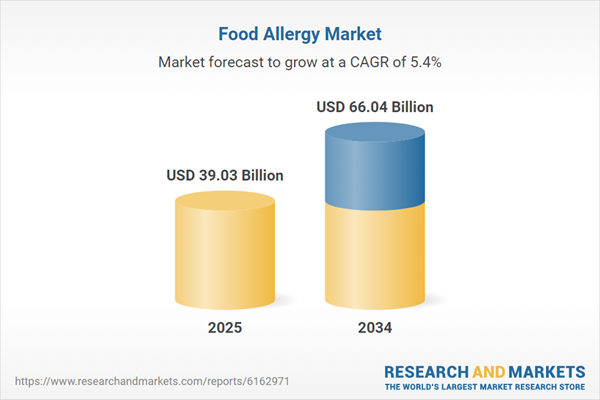Food Allergy: Introduction
Food allergy is a condition that occurs when a person's immune system gets triggered by a particular food item and exhibits several symptoms depending on the person and the food item. Most symptoms are visible only for a few hours. In severe cases, such as anaphylaxis, symptoms may persist for several days. Symptoms of food allergies include tingling or itching in the mouth, itchy red rash, swelling of the face, mouth, throat, or other areas of the body, difficulty swallowing, wheezing or shortness of breath, digestive problems, and swollen airways among others.Food Allergy Market Analysis
The market is driven by factors such as the rising prevalence of food allergies among children and adults. Due to the increasing prevalence, research institutes and key players in the market are expanding their sources and focusing on developing the best treatment for food-allergic patients across the 7 major markets. The continuous development of innovative solutions in the market can result in increased adoption as a major population is suffering from a common food allergy, especially to peanuts. This innovative technology and its increased adoption are also expected to trigger research and development activities to find solutions for other food allergies including tree nuts, propelling the food allergy market growth.Additionally, a new research and innovation project is targeting the development of novel immunotherapeutic drugs for peanut and multiple tree nut allergies. The project is a collaboration between DTU National Food Institute, The Hospital for Sick Children (SickKids) in Canada, and the pharmaceutical company ALK. The project ALLEVIATE2 will complete the preclinical development of sublingual immunotherapy drug candidates for the treatment of peanut allergy first. If this goes well and happens to be successful, the project will subsequently apply the same therapeutic approach and develop new treatments for tree nut allergies as well. This project has been funded with 18.5 million DKK (Danish Krone) by the Innovation Fund Denmark.
Innovations and research activities in the field of food allergies have been driving the market growth due to the limited treatment options available in the. These efforts from researchers and institutes can assist pharmaceutical and biotechnology companies in developing new treatments that can improve the quality of life for food allergy patients, further boosting the market.
Food Allergy Market Segmentations
“Food Allergy Market Report and Forecast 2025-2034” offers a detailed analysis of the market based on the following segments:Market Breakup by Food Source
- Dairy Products
- Poultry Product
- Tree Nuts
- Peanuts
- Shellfish
- Wheat
- Soy
- Others
Market Breakup by Symptoms
- Anaphylaxis
- Atopic Dermatitis
- Others
Market Breakup by Diagnosis Test
- Skin-Prick Tests
- Blood Test
- Elimination Diet
- Oral Food Challenge
- Others
Market Breakup by Treatment Type
- Epinephrine
- Oral Immunotherapy
- Antihistamines
- Others
Market Breakup by Region
- United States
- United Kingdom
- Germany
- France
- Italy
- Spain
- Japan
Food Allergy Market Overview
The market is driven by the increasing population allergic to food items. Rising investments in research and development activities targeted toward comprehending the mechanism of food allergies and the development of suitable treatments, drugs, and other innovative solutions are contributing to the market growth. The growing awareness of this condition among more people coupled with the increased demand for effective management and treatment options is expected to drive the food allergy market growth in the forecast period. The market growth is also attributed to increased investments by the government in research activities by scientists and key market players coupled with advanced development of technologies.The Centers for Disease Control & Prevention (CDC) estimates that almost 6% of U.S. adults and children have a food allergy. The most common food allergies among Americans are shellfish, peanuts, milk, and tree nuts. About 200,000 Americans seek emergency medical care for life-threatening allergic reactions to food, known as anaphylaxis, each year. These medical conditions approximately contribute to USD 25 billion every year, driving the market growth.
Food Allergy Market: Competitor Landscape
The key features of the market report include patent analysis, grants analysis, clinical trials analysis, funding and investment analysis, partnerships, and collaborations analysis by the leading key players. The major companies in the market are as follows:- Pfizer Inc.
- GlaxoSmithKline plc
- Novartis AG
- Mylan N.V.
- Teva Pharmaceutical Industries
- Sanofi
- Boehringer Ingelheim International GmbH
- AstraZeneca
- Johnson & Johnson Private Limited
- Bayer AG
This product will be delivered within 3-5 business days.
Table of Contents
Companies Mentioned
- Pfizer Inc.
- GlaxoSmithKline plc
- Novartis AG
- Mylan N.V.
- Teva Pharmaceutical Industries
- Sanofi
- Boehringer Ingelheim International GmbH
- AstraZeneca
- Johnson & Johnson Private Limited
- Bayer AG
Table Information
| Report Attribute | Details |
|---|---|
| No. of Pages | 350 |
| Published | July 2025 |
| Forecast Period | 2025 - 2034 |
| Estimated Market Value ( USD | $ 39.03 Billion |
| Forecasted Market Value ( USD | $ 66.04 Billion |
| Compound Annual Growth Rate | 5.4% |
| Regions Covered | Global |
| No. of Companies Mentioned | 10 |









